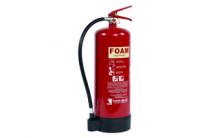Fire extinguishers explained the uses and types of different extinguishers
Fire extinguishers explained the uses and types of different extinguishers
Every business in the UK is required to carry out a fire risk assessment, have appropriate fire extinguishers in place, and ensure regular servicing.
It’s a simple rule designed to ensure work environments and the people working within them, or visiting are kept safe.
It’s little wonder – the obvious consequences of fire, with the significant risk of injury to people and property, means that legislation is strict and failure to comply is not an option.
Yet the rules and regulations, and the practicalities of keeping compliant can be less straightforward.
That’s why so many businesses choose to delegate their fire safety maintenance and compliance to fire safety specialists.
Bull Products are experts in fire safety, and supply fire safety products, services, support and advice to the UK building and construction industry – and have done so since 2006.
The company works with its clients to assess each workplace for its specific fire safety requirements. Its nationwide BAFE or FETA accredited engineers ensure clients get the best fire safety advice, service, training and assessments possible, and all in accordance with the British Standard.
Why are there so many different types of fire extinguisher?
There’s no such thing as a universal fire extinguisher, and no single fire extinguisher can be used for every type of fire.
Different materials burn in different ways, posing different hazards and demanding different responses. Having the right extinguishers for the environment and the risks involved is essential.
Bull stock and supply the full range of regulation-compliant fire extinguishers (with more than 50 different models listed on its website), which means a workplace can be kept safe, whatever the environment and risks.
The fire classification system (Class A-F) grades each type of fire according to the combustible materials involved. Likewise, all fire extinguishers manufactured in the UK have been specifically developed with different properties to combat each type of fire.
With colour-coded labelling that corresponds to the universal fire classification system, emergency fire responders are able to swiftly select the type of extinguisher required to tackle a blaze.
What types of fire extinguishers are used for what types of fire?
Combustible solids such as paper and wood (Class A fires) need to be tackled with water, foam or dry fire extinguishers. Flammable liquid fires (Class B fires) require foam or dry powder fire extinguishers, fires involving flammable gases (Class C fires) need dry powder fire extinguishers, flammable metals (Class D fires) require specialist powder extinguishers, combustible cooking oils (Class F fires) require wet chemical extinguishers and electrical fires require Co2 fire extinguishers.
Standard fire extinguishers
Water fire extinguishers
Colour-coded red and used for Class A fires involving materials such as paper, wood, soft furnishings and plastic, water fire extinguishers work by soaking and cooling the burning materials.
Water extinguishers are unsuitable for electrical fires, or for tackling burning fat or oil, but water extinguishers with additives provide additional fire-fighting power and may be safe for accidental use on electricity.
Foam extinguishers
Colour-coded cream and used for Class A and B fires involving paper, wood, cloth or plastic, and flammable liquids including paraffin, petrol and oil, foam fire extinguishers smother the fire with a foam film, starving the fire of oxygen whilst also cooling the burning materials.
More versatile than water fire extinguishers, foam extinguishers are typically safer should the foam come into contact with live electricity.
Powder extinguishers
Colour coded blue, ABC powder extinguishers, or dry powder extinguishers are multi-purpose extinguishers that can fight Class A, B and C fires – solids, flammable liquids and flammable gases.
Additional hazards involved with using powder extinguishers include inhalation risks (so should never be used in small spaces), limitations to vision, and the risk of the fire reigniting. Plus, powder extinguishers leave messy residue, making the clean-up operation an even greater challenge.
CO2 extinguishers
Suitable for Class E fires involving electrical equipment as well as Class B liquid fires, carbon dioxide suffocates the fire leaving no residue (unlike foam). It’s important to eliminate the source of the fire (e.g. by cooling the source or turning off the power supply in the case of electrical fires) to prevent the fire from reigniting. When used in a confined space it’s important to ventilate the area as soon as the fire is under control in order to prevent asphyxiation.
Specialist fire extinguishers
Wet chemical extinguishers
Colour-coded canary yellow and used for Class F fires – cooking oils and fats, wet chemical extinguishers.
Bull’s Chrome range
For executive and luxury environments, Bull’s Chrome range offers the functionality of all of its standard extinguishers, but with a more refined and premium appearance.
Put your fire safety in Bull’s hands
Bull’s expert engineers can assess the specific risks for a work environment and advise on the appropriate types of extinguishers required to keep a work environment safe and a business compliant.
It can also provide specialist training in fire safety awareness, as well as give advice on how to operate extinguishers safely.
Additionally, Bull can arrange all fire extinguisher servicing and repair, and if it makes financial sense for your business, you can even hire fire extinguishers directly from them.
For more information about Bull’s extinguishers and fire safety services available, talk to one of the knowledgeable and friendly advisors on 01432 806806 / enquiries@bullproducts.co.uk.
Published May 2017


